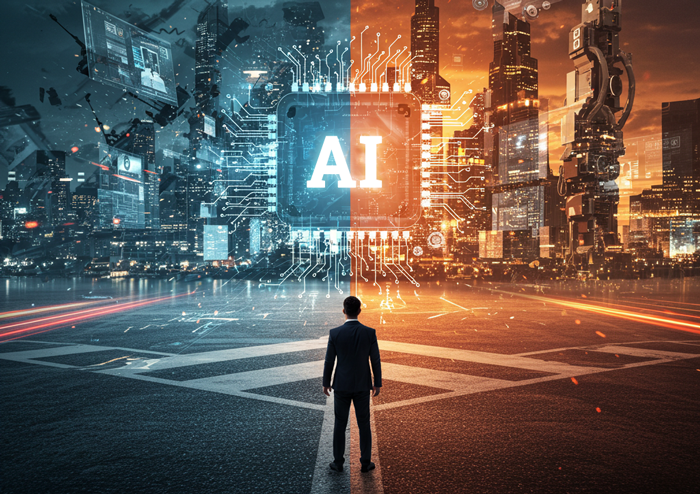There are countless blogs and musings on our future alongside artificial intelligence and the opportunities this marvel of human invention presents and the transformation it demands. This is not one of them.
Instead, this musing is about the how the change happens, not just what that change will look like.
The AI Enterprise. A Dream or a Nightmare?
Books and thought leaders paint a picture of an “AI Enterprise,” where human endeavour is limited to oversight and exception handling. Every process, large or small, simple or complex has been automated. Models have been trained; data transmission has been integrated, and keyboards have been banished to landfill. Oh, joy!
How will the mighty banks, insurance companies, government departments, logistics firms and local councils achieve such widespread, business-as-usual intrusive change? And at what cost?
Is there sufficient AI expertise within our system integrators? Enough programme managers to turn these slow-moving dinosaurs into agile, AI organisations?
Ultimately, the real question is How do you transform? Get it wrong and you face corporate Darwinism. A blind alley leading to extinction.

Doom Scenarios: The Many Ways AI Can Go Wrong
The Mammoth Scenario
The Mouse Scenario
The Wild West Scenario
The Ice Age Scenario
The Skunk Works Scenario
The Ostrich Scenario
The One Truth About Change. It’s Human, Stupid!
Any technology inspired programme of change in the last 40 years, whether public or private sector, has suffered from budgeting and scoping challenges, skill gaps in emerging technologies, poor design and overoptimistic “forecasting” of business benefits.
One consistent truth remains. Failure to engage the people affected by change leads to failure.
Real transformation isn’t imposed. It’s embraced. Succes comes from education throughout the build process, genuine user acceptance testing, respected champions of change advocating for benefits and a well-planned, well executed rollout.
After all we are human, stupid. We don’t like to be told to do things differently, but we cannot resist the natural desire to improve the way we work. Embrace it, support it, own the shape of it.
Embrace the Ego and the Thirst for Self-Improvement
“I am an expert. No one does my job better.”
“…and definitely not those management consultants or those offshore IT guys!”
That mindset is not a problem it’s an opportunity. Who better to innovate and deliver change than those who know the job best.
Today’s PlayStation generation has access to low-code and generative AI tools allowing them to optimise not just manual tasks but entire workflows. This is where real transformation happens.
Change by the people, for the people.
All processes share common elements:
- Receiving data
- Extracting and synthesising data
- Transmitting data
- Applying business rules
So why not let the business experts, the ones closest to the process, lead the change?

A Case Study in DIY AI Transformation
At a top 5 US bank, a bold new approach to AI transformation is unfolding.
Rather than waiting for IT-led change, they’ve empowered their employees with AI and RPA tools, training and support to improve their own workflows. Changing the future of the bank with a Do-It-Yourself approach.
An Unlikely Champion Finding the Tools for the Job
Surprisingly, this initiative is led by the Risk Strategy team. Faced with increasing workload demands, The SVP of Risk Strategy needed a solution that didn’t involve endless hiring and training.
Most of their processes involved reviewing documents, extracting data, and comparing records across core banking systems. While repetitive data entry and simple comparisons could be handled by robotic process automation (RPA), the real challenge was finding a user-friendly AI tool that could quickly process advanced and complex documents.
That’s when they discovered AntWorks CMR+.

How DIY Transformation Works
The bank’s innovative approach to engaging the organisation is incredibly effective. It leverages advances in low-code AI technologies, empowering experts to build AI copilot solutions and achieve trusted straight-through processing. Confident in the accuracy, which is audited and proven to be superior to their previous methods.
Seven quarters in, the process continues to evolve. Every quarter, the bank selects volunteer colleagues to attend one of two HQ centres in the US. Each participant brings candidate use cases. In collaborative sessions, the use cases are reviewed by a team of experts, and the best fits are selected based on business priority, business case, and tool compatibility. Following this, colleagues receive training on the chosen tools a critical step where the right tool selection is paramount.
The AntWorks AI platform CMR+ for document processing, data extraction and standardisation delivers complex AI capabilities, including GenAI, ML, NLP, business rules and Small Language Models. Training to a good standard can be achieved over three elapsed days (9 hours facilitated online training) . Complimented by a powerful RPA tool for data transmission, the business colleagues are equipped to feel confident and effective in automating the processes and document handling that is their daily routine.
This transformation doesn’t happen overnight. After their initial training, colleagues return to their day jobs, invigorated and part of virtual teams. Supported by the risk automation central team, they complete their projects within a newly forged network of like-minded colleagues across the bank.
Little processes, big prizes
Most large-scale AI transformations focus on big-ticket processes with high volume and clear ROI. But this bank realised that 60% of processes are “small” but mission-critical, consuming the time of experienced employees.
By tackling these small processes at scale, they’ve unlocked a big prize:
44 use cases automated
in 14 months
AI document processing efficiencies in bankruptcy, AML, mortgages, small business lending, home equity release, and check processing
8x productivity improvement in risk and compliance
Reduced compliance risk
and remediation costs
Enhanced employee morale and upskilling
And all of this was achieved without a massive IT-led transformation project.
DIY Aids Adoption
Like a homeowner proudly showing off their DIY projects to neighbours, employees take ownership of the transformation they’ve learned and helped to build.
The lesson? Adoption is easier when transformation is employee-led. Trust in AI is higher when its benefits are seen firsthand, and colleagues who build solutions become the strongest advocates for change.
This approach doesn’t just drive efficiency. It reshapes the workforce, fosters innovation and creates a culture of continuous improvement.
After all, transformation isn’t about AI replacing humans. It’s about AI empowering them.

